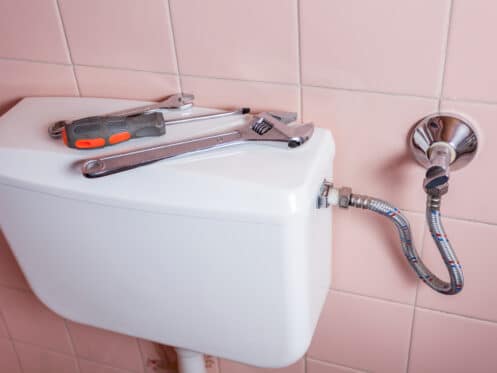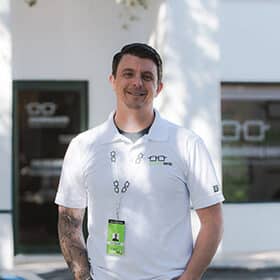At Plumbing & Cooling Nerds, we understand the frustration that comes with a toilet overflow. It’s a common issue, but we’re here to help you prevent it. In this guide, we’ll share 10 effective strategies to maintain your toilet’s proper function and avoid those inconvenient overflows.
1. Only Flush Human Waste and Toilet Paper
The single best way to keep a toilet from overflowing is to only flush human waste and toilet paper. Human waste obviously needs to be flushed down the toilet to dispose of it safely, and toilet paper was designed to break down after use. Toilet paper is safe for all toilets, whether you’re on the city sewer system or have a septic tank.
Nothing else should be flushed down your toilet, not even “flushable” wipes. Such things may be advertised as “flushable,” and manufacturer tests seem to show they are. However, other studies have suggested that “flushable” items can clog sewer lines, leading to backed-up toilets. Any trash that isn’t toilet paper should be thrown in a waste basket.
2. Use Less Toilet Paper
Even though toilet paper is safe to flush, you can still clog up a toilet if you use too much. As a rule, you should only use as much toilet paper as you need without sacrificing cleanliness. If you need too much toilet paper, either switch to thinner paper that is less likely to clog your toilet or use shorter lengths. A little toilet paper goes a long way, even if it may not seem like it.
3. Flush Frequently
With modern toilets, flushing uses less than two gallons. Frequent flushing prevents your toilet from overflowing and potentially wasting more water. If you’re sitting on the toilet for a long time and will use a lot of toilet paper, flush once or more times before you’re finished. When you flush a second or third time, you’ll be less likely to contend with an overflow.
4. Check for Clogs Before Flushing
Before you sit down, check to ensure the toilet isn’t clogged. Clogs in a toilet are easier to see than you think. If you notice anything floating in the bowl, it didn’t flush fully. Try flushing again before adding more waste to see if it empties completely. If not, you can unclog the bowl before adding to it.
A safe rule of thumb is to check the toilet before using it. This allows you to retrieve toiletries, bath toys, or anything else that might be carelessly thrown into your bowl. The bottom line here is to always look before you flush. Never assume that everything in the bowl will flush safely.
5. Flush With a Smaller Amount of Water
If you have an older toilet, it might use as much as five gallons per flush. That’s a lot of cleanup if it does overflow. For many reasons, the best option is to invest in a low-flow toilet. You can contact us at Plumbing & Cooling Nerds about having your toilet checked and repaired or replaced.
If replacing your toilet is not currently possible, you can reduce the amount of water being used. One option is to hang a sealed bottle or bag full of water inside your toilet tank. This displaces the amount of water that drains into the bowl. Another option is to adjust the water level in the tank. For older toilets, you can adjust or bend the rod attached to the float. Other models might have a valve, screw, or dial that sets the water level.
6. Check Your Toilet for Leaks and Other Issues
Sometimes, a toilet plugs up and overflows not because of what you’re flushing but because there is something wrong with it. It could be that the flapper inside the tank is leaking, or you might have a leak elsewhere in your toilet. Check your toilet frequently for cracks and other leaks, and don’t hesitate to contact us if you suspect that you do have a leak.
7. Clean Your Toilet Regularly
Cleaning your toilet regularly isn’t just a good sanitary measure; it can remove a buildup along the rim that can cause clogs and overflow. Clean your toilet thoroughly at least once a week, and wipe off the rim of the toilet bowl after every use. This will prevent buildup that can lead to a clog and an overflow.
8. Avoid Harsh Cleaners
Cleaning products that contain chlorine bleach and other caustic ingredients erode the porcelain in your toilet. Over time, eroding porcelain can cause leaks and overflows. They are also more dangerous for you and the rest of your family if they get onto your skin or are swallowed. Instead, switch to cleaners with gentle ingredients designed to not damage porcelain and other surfaces.
9. Have Your Plumbing Inspected and Cleaned Regularly
In many cases, toilet clogs and overflows are caused by a larger problem in your home’s plumbing system. Sewer lines can clog, septic tanks overflow, and mineral buildup can slow down water flowing through your pipes. Ideally, your home’s plumbing system should be inspected at least once every three to five years. Meanwhile, your drains should be cleaned thoroughly at least once a year. At Plumbing & Cooling Nerds, we offer hydro jetting, which is a safe and effective way of thoroughly cleaning drains.
If you have an older home, roots can invade sewer lines through small cracks and holes, which will cause drains and toilets to back up and overflow. If an inspection reveals this to be the problem, we offer sewer line repairs to prevent this problem.
10. Keep a Plunger Handy
Even though you shouldn’t hesitate to call us if you have a serious problem with your toilet, keeping a plunger on hand to clear minor clogs is still good practice. Make sure that this is a flange plunger that can be used with a toilet. A flange plunger will have a smaller cup at the end of the main cup. The smaller cup fits into the drain at the bottom of the toilet bowl and creates the tight seal necessary for removing a toilet clog. Keep this next to your toilet, and be ready to use it if you think your toilet is going to overflow.
Contact Plumbing & Cooling Nerds for Your Plumbing Needs
An overflowing toilet seems like the kind of plumbing problem you can deal with yourself. However, frequent clogs and overflows usually indicate something much worse in your home’s plumbing. If you have frequent toilet overflows, we at Plumbing & Cooling Nerds will be happy to look at your toilet to find the problem; contact us for a toilet repair! We also provide other plumbing services such as leak detection, water filtration, repiping, water heater installation, and much more. We also offer AC and heating repair and installation.
For more information about our plumbing services or to schedule a visit to your home in Naples or anywhere in southwest Florida, contact Plumbing & Cooling Nerds today.

